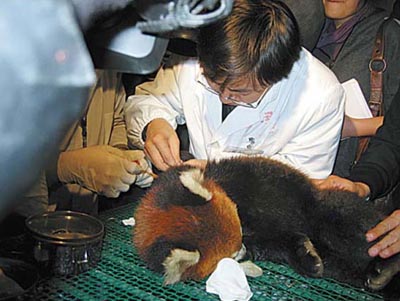A lesser panda saved from the clutches of death last Friday has become the star attraction at Chengdu Zoo in Sichuan Province.
Visitors are flocking to the zoo for a glimpse of the animal, also known as the red or small panda, recovering from an afternoon-long ordeal in the Heishuihe Nature Reserve in Dayi County.
Deng Jiabo, a vet with the Chengdu Zoo, gives the rescued lesser panda a physical check-up. The panda is recovering well and may be sent back to where it was found or cared for in the zoo.
The creature was found amid snow-covered trees in the highlands by the reserve's employee, Xing Chunming.
"It was covered with snow and frozen stiff," said Xing.
Xing brought the panda down from the branches with the help of colleagues and wrapped the poor beast in his clothes.
The rescuers contacted the reserve's administrative department and the Dayi County forestry bureau, which arranged to meet them on the highway at the foot of the mountain.
Buffeted by heavy snowfall and faced with slippery roads 2,800m above sea level, the group spent more than three hours to reach the ambulance waiting for them.
When Xing transferred the panda to the ambulance, the creature stirred from the warmth and opened its eyes.
"It suddenly clawed my left arm and even injured me slightly," Xing said.
The animal was rushed to the zoo and arrived after 8 pm. Vets from the city's wildlife rescue center gave it shots, measured its temperature and collected blood samples to see if it was running a fever.
"Tests showed the panda did not suffer from any fracture and was not running a fever," said Tian Yuzhong, chief of the Chengdu Zoo.
On the first two days after its arrival in the center, the panda ate little and showed little interest in bamboo leaves.
"Lesser pandas are omnivorous in the wild. They prey on birds, eat their eggs and survive on bamboo leaves. Bamboo leaves are their favorite food," Tian said.
But the panda is getting used to apples, carrot and buns the zoo provides.
"The buns are nutritious, being made of fish and bone meal, vitamins and milk powder," Tian said.
"It looks scared whenever people enter its den. So we have only a keeper and vet to take care of it," said Tian, who added the panda is an adult male weighing 5 kg. Its age cannot be determined, he said.
To everyone's delight, the panda is recovering well and may be sent back to where it was found or cared for in the zoo.
"According to State regulations, departments in charge of forestry will decide whether rescued wild animals should be sent back to the wild or kept in zoos," said Zhu Shang, the chief of the wildlife protection section of the Chengdu gardening and forestry bureau.
Wang Qiang, the chief of the city's wildlife rescue center, said the center has rescued 98 wild animals since it was established in the zoo last November.
Set up in 1953, the Chengdu Zoo, which has three giant pandas on display, won the Global 500 environmental award from the United Nations Environmental Program (UNEP) in 1989 for its contributions to the lives of giant pandas.
In the 1980s, Fargesia spathacea Franch - a type of bamboo the giant panda eats - blossomed nationwide.
The bears faced food shortages as the bamboo they like flowered and died without being replaced.
"The Chengdu Zoo has saved lots of hungry and sick pandas from the wild," Tian said.
(China Daily November 15, 2007)






